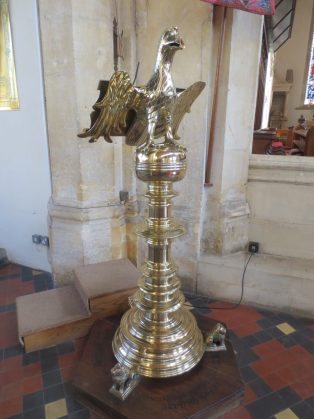The Baptist Hicks Lectern
Michael Smedley
This lectern has been a fascination of mine since first seeing it with my parents many years ago. Lecterns of this form were made in quite a well-defined period, between 1470 and 1530. Opinions by scholars have varied as to where they were made. Certainly Flanders is a strong possibility as it was a brass making centre and foundries were well established there and in North Germany supplying metal wares for example alms dishes, all over Europe.
In 1930 Charles C. Oman, then keeper of the Department of Metalwork at the V&A, published a fascinating article in the Archaeological Journal, volume 87, in which our lectern is listed of one of the 45 late medieval (strictly speaking early Modern to historians) brass lecterns in England known then to be extant (including some non-eagle). Numbers have fluctuated slightly since then – Oman admitted he hadn’t visited all of them – one has since been dismissed as a 19th Century copy. The number of Eagle lecterns of this date in England (Wales and Scotland) is thought to be about 40.
From his studies he did however note certain basic models, which could be grouped stylistically, possibly indicating the same place of manufacture. The same wooden moulds were re-used, and plinths and feet also are distinguishable in groups.
Rather disparagingly he states ‘A conventionalised bird from a poor model and very poorly finished’ Of course finish can add detail and other models may have more detailed wings, feathers etc. or considered more ‘naturalistic’ as in series I or II, but this is perhaps a little subjective.
He notes a very large concentration of these lecterns extant in East Anglia. He also traces foundries in Norwich – the wonderfully named Richard Brasyer for example, sheriff in 1495 and mayor in 1510, and the equally wonderfully named Reignold Chirche in Bury St Edmonds recorded as in his will of 1498 being the second in succession to a prosperous firm of bellfounders. His son Thomas was charged to ‘clene the grete lectorn that I gave to Seynt Mary Chirche q’art’ly’ Other brasiers are noted in the area about this time in wills.







No Comments
Add a comment about this page